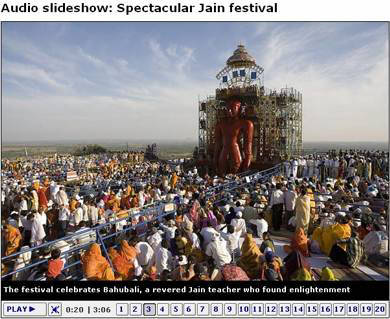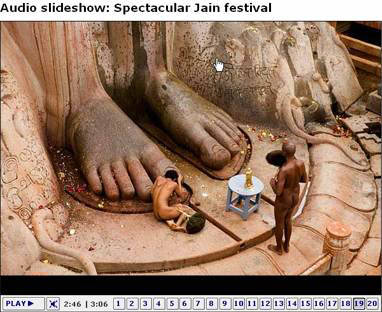The BBC website offers a wonderful Audio Slideshow of the event - really impressive
Photos: Karoki Lewis
Audio: Grant Gorden
http://news.bbc.co.uk/go/em/fr/-/1/hi/in_depth/629/629/4736362.stm
Mahamastakabhisheka 2006
Mahamastakabhisheka: The bathing of a God - February 8, 2006 was a big day for Shravanabelagola in Karnataka. It marked the millennium's first Mahamastakabisheka, the head anointing ceremony of revered Jain icon Lord Bahubali, or Gomateshwara. As with all things holy, the day-long ceremony began with prayer. Jain monks carried the holy water from the Digambar Jain mutt to the venue. To the chant of hymns, the pontiff Charukeerthi Bhattarka filled a giant pot with rice and sealed it with silver coconut, signalling the inauguration of the spectacular event.
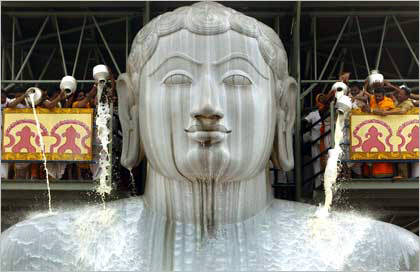
At an auspicious moment, two monks hoisted the first pot on the shoulders of a devotee from Rajasthan called Ashok Kumar Patni. The latter had the privilege of pouring the first stream of holy water on the head of the world's tallest free-standing statue.
The ceremony, which comes once in 12 years and lasts over six hours, began at 10.41 am when the 1,024-year-old monolith was anointed. Priests climbed the special scaffolding and assisted pot-holders in anointing the statue with water, coconut, sugarcane juice, rice flour, herbs, milk, sandal paste, turmeric, precious stones, and 52 varieties of flowers from around the world. Patni, a marble trader, won the right to pour the first pot by bidding the highest amount of Rs 1.08 crore.

Dressed in saffron and white, thousands of devotees gathered at the Chandragiri and Vindyagiri Hills for the grand event. As trumpets marked the beginning of the rare, auspicious ceremony, thousands looked up to witness the anointing.
For six hours, 108 jal kalashas (pots) were poured on Bahubali by devotees from around the world. 1,000 litres of milk, 3,000 litres of water, 250 kilograms of turmeric and sandal were poured on the gigantic statue, which kept changing colour, much to the awe of the world media that had gathered to document proceedings.
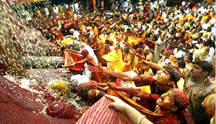
The statue of Gomateshwara, often referred to as the 'monk on the hills', has attracted millions of people, from devotees and tourists to lovers of art, since it was erected in 981 AD by Chavundaraya, prime minister and commander-in-chief of the Talakad Ganga kingdom. It was erected in memory of Lord Bahubali, a victorious king who renounced all worldly pleasures for spiritual pursuits. Bahubali stands erect in the Kayotsarga pose, arms dangling free. He is visible to a distance of around 16 kilometres, and continues to hypnotise a thousand years after he first set his sights on humankind.
The last Mahamastakabhisheka venerating Gomateshwara Bahubali took place on December 19, 1993. Little about the ceremony has changed, except for the finale in recent years that has included an enormous shower of flowers from a helicopter.
The stone sculpture symbolises renunciation, self-control and subjugation of the ego as the first steps towards salvation. The nude form -- also referred to as Digambara -- of Lord Bahubali, represents complete victory over earthly desire that hampers one's spiritual ascent towards the divine. The rite of the sacred bath occupies an important place in Hindu practice as well as Buddhist and Jain.
The next Mahamastakabhisheka will be held in 2018. Until then, all we have are our pictures to remind us of its magnificence. Report Courtesy: Mr. Gaurav Jain, E-Mail: (Rediff.com)
Rajasthan's Ashok Patni Offered First Kalasha Abhisheka For Rs. 1.08 Crores
The anointing ceremony began at 10.35 a.m. with abhisheka and offerings. The first abhisheka was performed by Ashok Patni of Rajasthan with 500 tender coconuts, 300 kalashas of Ikshurasa and other ingredients. The much sought after honour of offering the first kalasha at the Mahamastkabhisheka Mahotsava celebrations was offered to Mr. Ashok Kumar Patni from Rajasthan. Mr. Patni, hailing from Kishanganj, was chosen by Swasthishri Charukeerthi Bhattaraka for the honours, in recognition of the philanthropic act of his family donating a sum of Rs.1.08 crores toward the 100 beded Bahubali Children's Hospital constructed by the mutt and which was inaugurated by President APJ Abdul Kalam on Jan 22. Ashok Kumar Patni had made the donation in the memory of his father late Ratanlal Kavrilal Patni. The second kalasha performer was Babulalji Vijayakumar from Hyderabad, who gave away Rs 1 lakh.
The People's President Lights The Ceremonial Lamp At The Lord's Feet
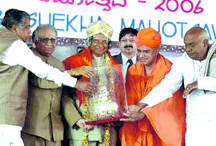
The second milleneum's first Mahamastakabhisheka on Sunday, January 22 got off to a colourful start with President A P J Abdul Kalam lighting the ceremonial lamp at Shravanabelagola, the site of the 17-meter high statue of Jain Lord Bahubali, claimed to be the world's tallest monolith. The lighting of the lamp is a traditional Indian way of signaling that the darkness is dispelled as an auspicious function begins. Inauguration of an event as important as Mahamastakabhisheka by a Muslim President signals the dispension of all borders that humans have erected around themselves in the name of religion, sect, region, race and others.
In Karnataka, where A P J Abdul Kalam has spent many years as a scientist in the Defence Research and Defence Organisation, he is seen as an epitome of tolerance, hard work and sincerity. The father of the Indian missile programes has journeyed from a small village to the Presidential Palace and Karnataka has a share in his success. It is no wonder then that the religious dignitaries at the prestigious Mahamastakabhisheka must have felt very honoured to have a sworn vegetarian secular President gracing the inauguration of the grand affair. While at Shravanbelagola, Kalam also inaugurated a Children's hospital, another sector he cares a lot about.
Vice President Shekhawat Visits Shravanabelagola
While delivering his address at Shravanbelgola on 6th February, Vice-President Bhairon Singh Shekhawat exhorted the prosperous to contribute a part of their earnings for the poor and the downtrodden, which, he said, would be the "true homage to Lord Bahubali on this occasion. Inaugurating the Rajyabhiseka ceremony of Lord Adinatha, the first Tirthankara and father of Bahubali, as part of the Mahamastakabhisheka Mohotsav, he said "if all prosperous people start following the principles of Ahimsa and Aprigrah (Sacrifice) and adopt a poor family or a village and work for their uplift, poverty in our country can be eliminated easily". If the Munis and Acharyas can inspire millions of pilgrims visiting the place on the occasion "to contribute a part of their earnings to help the poor, they would be rendering a great service to humanity", he said. Shekhawat also laid the foundation stone for a girls' hostel here.
Grand Spectacle Unfolds At Shravanabelagola
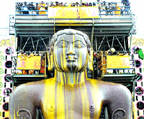
It was a sight for the gods to behold as the visual splendour of the Mahamastakabhisheka unfolded to a sea of humanity, which danced in rapture at the changing colours of Gomateshwara atop the Vindhyagiri Hill to give a spectacular start to the first grand anointment of the new millennium. The 58-ft-tall world's largest monolithic statue was the cynosure of all eyes as the grey-coloured granite figure turned reddish-brown only to appear in a dazzling white before it turned to golden-yellow.
The riot of colours and the exoticism associated with the event held the devotees spellbound as the cascading milk, vermilion, tender coconut, turmeric, saffron and different varieties of ashwagandha enveloped the magnificent Gomateshwara, whose benign smile seemed appreciative of the event. Devotees cutting across religious beliefs, who witnessed the event, felt blessed at the feet of Lord Bahubali, whose message of peace and non-violence holds good even today. The pilgrims' progress to the Vindhyagiri Hill located 3,300 ft above sea level commenced at the crack of dawn as young and old wound their way up the 624 steps chanting "Bhagavan Bahubali Gomateshwara ki Jai" at every step, paused for breath, and made their way up again to catch a glimpse of what is for many a once-in-a-lifetime event.
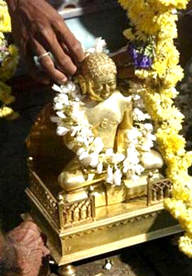
The anointing ceremony began at 10.35 a.m. with abhisheka and offerings of water and tender coconut. The first abhisheka was performed by Ashok Patni of Rajasthan. The first part of the elaborate ritual continued till 2.15 p.m. and the devotees rejoiced in the pious act of making divine offerings and spent time in prayer and meditation. But the spectacle for which Mahamastakabhisheka is renowned began soon afterwards, and the 5,000-strong devotees privileged to be near the statue were thrilled along with the thousands of others who milled around the Vindhyagiri Hill and Chandragiri Hill to catch a glimpse of the spectacle. A unique feature of the event was the use of "Iksharasa," reckoned to have been first partaken by Bahubali after his enlightenment. This signalled the commencement of the colourful event that turned out to be celestial in its grandeur and intensity.
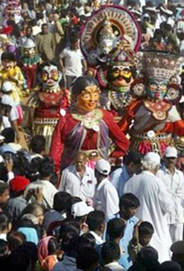
As the anointment ceremony unfolded, Shravanabelagola became a picture of oriental ritual as described by travellers of yore. The presence of over 160 Jain monks from across the country added to the ambience. In all, 108 kalashas, 500 tender coconuts, 300 kalashas of Ikshurasa, 300 kalashas of milk, 100 kg of milled rice, 25 kg of sandalwood paste, 25 kg of turmeric paste and other ingredients were offered to the Lord of the Vindhyagiri with the grand finale for the day being the showering of petals brought from six countries. The "sacred bath" culminated with the setting sun bathing the statue in a red hue.
Located 120 km from Bangalore, Shravanabelagola became prominent when the first empire builder of India, Chandagupta Maurya, abdicated the throne, embraced Jainism and came down to Shravanabelagola with the Jain pontiff Shrutikevali Bhadrabahu in the 3rd Century B.C. Like a true Jaina, he fasted to attain salvation. It was between 978 A.D. and 993 A.D that the present statue was conceived by the commander-in-chief of the Ganga dynasty, Chamundaraya. According to the Jain tradition, the first great anointment of the statute took place in 981 and this is the 86th Mahamastakabhisheka. Sri Charukeerthi Bhattaraka Swamiji supervised the conduct of the Mahamastakabhisheka in the presence of Sri Vardhaman Sagar Muni and Acharya Gunanandhi Muni.
Mahamastakabhisheka: 38 Jains Initiated At The Mega Deeksha
Rani Jain, a 26-year-old girl from Chatarpur, Rajasthan, was one among 36 Jains nuns initiated at the Jain muni deeksha at Shravanbelgola.. The rigors of becoming a Jain nun or monk was keenly felt by the crowd who watched spell bound as Rani's flowing locks were plucked by the arikas after the Brahmacharini sought the permission of the gathering to become a nun. She was then initiated at the Panchakalyana Vedike at the Tyaginagarin in Shravanbelgola. With dharmic fervour, 36 Jains, including 13 women, were initiated as monks in the presence of acharyas, arikas, the Shravanabelagola pontiff Swasthishri Karmayogi Charukeerthi Bhattaraka Swamiji and the Bhattarakas of Moodabidri Jain Kashi Maha Samsthan and the Kanakagiri Jain Mutt. The initiation ceremony began at 4.30 AM with the managalasnana and keshalonchana, the manual plucking of the hair, before the participants were initiated. At the ceremony, two women were initiated as Brahmacharinis, while eleven Brahmacharinis were initiated as Arikas. Eight Ilak monks were initiated as Kshullaks and six Kshullaks as Munis. Kshullika 104, Gurumathimataji, was initiated as Arika by Prathama Ganini Arika Sri 104 Vijayamathi Mataji. Eight Brahmacharis were elevated to the rank of Ilaks and the remaining Brahmacharinis as Kshullikas. The devotees, a large number of whom belonged to the Sangha of Acharya Shri 108 Viragasagar Maharaj followed by Prathama Ganini Sri 104 Vijaymathi Mataji and Acharya Sri 108 Varadhattasagar Maharaj were initiated by the plucking of hair, the anointing of their heads with holy water, and placing of grains and Jain symbols amidst the chanting hymns.
Former Prime Minister, H. D. Deve Gowda participated in the special programme during the Mahamastakabhisheka at Pancha Kalyan mantap in Tyaginagar. Deve Gowda along with his wife Chennamma took the blessings of Acharya Vardhamanasagar munimaharaj, Krantikarimuni Tarunsagar Munimaharaj and Charukeerthi munimaharaj. Later, the former prime minister participated in mahamastakabhisheka atop Vindhyagiri Hills and anointed Lord Bahubali with Kalasha of holy water. Deve Gowda was taken in a palanquin to Vindhyagiri.
102 Years Old Attends Bahubali Mahamastakabhisheka Fifth Time
102 years old Rao Manikchand Shah Indikar, a freedom fighter and a Jain devotee, hailing from Indi in Bijapur attended for the fifth time Mahamastakabhisheka ceremony of Lord Bahubali. Recalling his first visit to the site he remembered that in earlier days they could complete the ceremony in just two hours and also circle the statue. Shah has been conferred with 'Teerthabhaktha Gourav Sanman' award by the Shravanabelagola Charukeerthi Bhattakra two years ago for his efforts in developing the Parswanath temple at Bijapur.
